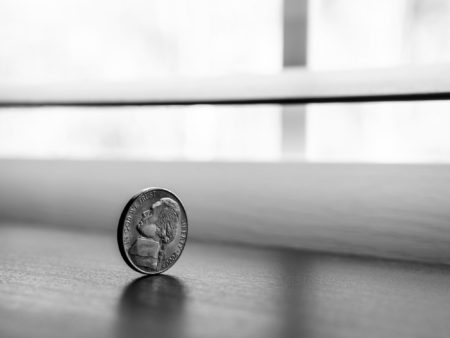8 Science Myths Busted
We put eight of the most persistent science myths under the microscope
1. “COIN FLIPS ARE 50:50”

If there’s one thing that we know for sure, it’s that a series of coin tosses will come out half heads and half tails. Wrong. Coin flips aren’t completely independent. True, the coin doesn’t know what side it landed on last time, so if you got five heads in a row, you aren’t overdue a tails. But the side that faces upwards when you make the flip influences the side it’ll land on. Researchers from Stanford University and University of California, Santa Cruz watched coin flips with a high-speed camera. They found that if you flip a coin head-side up you have a 51 per cent chance of catching it head-side up. And, for some people, the chance can be as high as 60 per cent depending on exactly how they flip the coin. What’s more, if you spin the coin, the lightest side will face up more often than the heaviest. This tends to be tails, but it depends on the exact coin you use. The advantage is tiny but well worth knowing about if you’re betting on a coin toss.
2. “CRACKING KNUCKLES WILL CAUSE ARTHRITIS”

Knuckle cracking involves pulling apart the joints by stretching or bending them, which decreases the pressure in the fluid between them. This causes dissolved gases in the fluid to form bubbles, which then burst with a characteristic crack. Legend has it that this causes osteoarthritis, where the cartilage covering the ends of the bones becomes thin and roughens. But this legend isn’t true. In 1998, Dr Donald L Unger wrote a letter to the editor of Arthritis and Rheumatology. He had been cracking the knuckles of his left hand at least twice a day for 50 years, with his right hand acting as the control. He had compared both hands for evidence of arthritis and found none, but he did confess that his study wasn’t enough to debunk the myth. However, a larger study later appeared in the Journal of the American Board of Family Medicine. The team quizzed 215 people aged 50–89 about their knuckle-cracking habits and looked at X-rays of their hands. The result? There was no difference between those who cracked and those who didn’t.
3. “SHUFFLE ON MUSIC PLAYERS IS COMPLETELY RANDOM”

While the human species is already pretty smart, could we be even smarter? The old saying goes that we only use ten per cent of our brains. So just imagine what we could do if we kicked the other 90 per cent into gear. Not much more, as it turns out. The ten per cent figure is a myth. We don’t know exactly where the myth came from, but it may have started as a misinterpretation of early experiments on brains. The first cause could be the fact that during brain scans, not all parts of the brain light up, possibly leading early experts to assume that the darker areas were inactive. On top of this, there is the fact that people can survive damage to certain parts of the brain following a trauma such as a stroke. We each have around 86 billion nerve cells, or neurons, in our brains. Each one can have up to 100,000 dendrites, which are branches that help neurons to make connections to each other. Just by reading this page, you’re using almost every part of your brain. Your brainstem is taking care of your heart rate and breathing. Your cerebellum is keeping you balanced. Your occipital lobe is handling the input from your eyes. And your temporal, parietal and frontal lobes are working together to decode the words. All this brain activity, needs energy; up to 20 per cent of the body’s total in fact. That’s a lot for using just ten per cent of the brain. If this still isn’t enough, around half of your brain isn’t made of neurons but glial cells. The word is Greek for ‘glue’, and these cells sit between the neurons, providing support and protection. Then there are the astroglia, which help maintain chemical balance; oligodendrocytes, which insulate neurons; and the microglia that repair damage, fight infection and clean up debris. These cells are constantly active, blowing the ten per cent figure out of the water.
4. “IT TAKES SEVEN YEARS TO DIGEST CHEWING GUM”

It can take on average between one to three days for food to go all the way through your digestive system, but legend has it that gum stays in there for seven years! Luckily for any accidental gum swallowers, this simply isn’t true. So what exactly does happen to chewing gum when we swallow it? The chewy part of chewing gum is made of tough stuff — a natural or synthetic rubber base that even the digestive system can’t break down, able to withstand the stomach’s acid and the intestines’ digestive enzymes. But most other components, including sweeteners and flavourings, can be broken down. This means the body can deal with it, so the gum will eventually move towards the exit in a few days. If you swallow something smaller than two centimetres in diameter, chances are it’ll be able to squeeze out. And gum has the added benefit of being soft. There have been rare reports of children with gummed-up intestines, but they had swallowed vast quantities of the sticky stuff. Even so, chewing gum has no nutritional benefit, and can be a choking hazard, so you are still advised to spit it out.
5. “A PENNY DROPPED FROM A SKYSCRAPER COULD KILL SOMEONE”

There’s no need to fear for your life the next time you pass through the shadow of a skyscraper — pennies dropped from the rooftops aren’t going to pierce your skull. Intrepid investigators have put this myth to the test in ingenious ways, and it’s been well and truly busted. University of Virginia physics professor Louis Bloomfield was so confident that the myth was false that he sent a penny-loaded helium balloon into the sky. The pennies dropped like leaves in the air, buffeted by the wind. The faster they fell, the more air resistance they experienced. Pennies are too small and fl at to be a danger, only reaching speeds of around 40.2 kilometres per hour. At some point the downward force of gravity balances the upward force of air resistance, and the pennies can’t fall any faster. According to the MythBusters team, a penny dropped from the top of the Empire State Building might collide with the pavement at 103.6 kilometres per hour. So they made a gun that could fi re pennies at that speed. Although their test dummy may have suffered a little damage, when they turned on each other they were not harmed. According to Professor Bloomfield, if the coins fell in a vacuum they’d be much more dangerous, reaching a speed of 335.7 kilometres per hour. But even then they wouldn’t penetrate the skull. However, in an interview with Life’s Little Mysteries, he warned against ballpoint pens. The shape of these is more bullet-like, and if they come down straight they could get close to 335.7 kilometres per hour in the air, so the pointy end could do a lot more damage.
6. “SNEEZING WITH YOUR EYES OPEN WOULD MAKE YOUR EYES POP OUT”

People shut their eyes when they sneeze, but it’s not to prevent them from bulging out of their heads. We sneeze to clear irritants from our airways, and closing our eyes stops the same irritants from getting straight back in. It happens automatically, but if you do keep your eyes open it’s highly unlikely that anything bad will happen. In 1882, The New York Times reported a burst eyeball following a sneeze, and it’s true that straining can rupture blood vessels. A powerful sneeze or excessive coughing can cause a bleed in the eye. These injuries normally heal without any need for treatment, and they can happen whether your eyes are open or closed.
7. “WATER DRAINS IN THE OPPOSITE ROTATION IN THE SOUTHERN HEMISPHERE”

Earth is always spinning. It rotates from west to east, completing a full turn every 24 hours, and this causes something known as the Coriolis effect. Earth is a sphere, and it’s wider at the equator than it is at the poles. Therefore, for the whole planet to spin around in the same amount of time, the ground at the equator has to spin faster than the ground at the poles. If you were able to stand at the equator and throw a ball northwards towards your friend in the UK, it would appear to curve to the right because they are moving slower and have not caught up, while you conserve momentum. But if you were in the North Pole and threw a ball towards the UK, again it would curve to the right, but because the UK is moving faster than at the pole, your friends are now ahead of the ball. Back on terra firma, the effect is that liquids, including those in the air, deflect as they move. You can watch it happening in the spin of hurricanes, which turn in different directions in the Northern and Southern hemispheres. But this effect isn’t strong enough to affect water draining from our sinks: the Earth just isn’t moving fast enough.
7. “HAIR AND NAILS CONTINUE TO GROW AFTER YOU DIE”

Medical students and morticians might notice cadavers with fresh stubble, but there isn’t a mysterious life force inside the follicles. It may look like new cells are growing at the roots, but appearances can be deceiving. After death, the body starts to dry out and, as skin loses moisture, it shrinks. What looks like new growth is just hair and nails that were once hidden underneath being revealed. Many of our cells do stay alive longer than us. Studies looking at the genes of animals in the four days after they died showed that many cells activated automated stress responses after death. Stem cells in particular fight to survive as long as possible.
This article was originally published in How It Works issue 108, written by Laura Mears
For more science and technology articles, pick up the latest copy of How It Works from all good retailers or from our website now. If you have a tablet or smartphone, you can also download the digital version onto your iOS or Android device. To make sure you never miss an issue of How It Works magazine, subscribe today!






